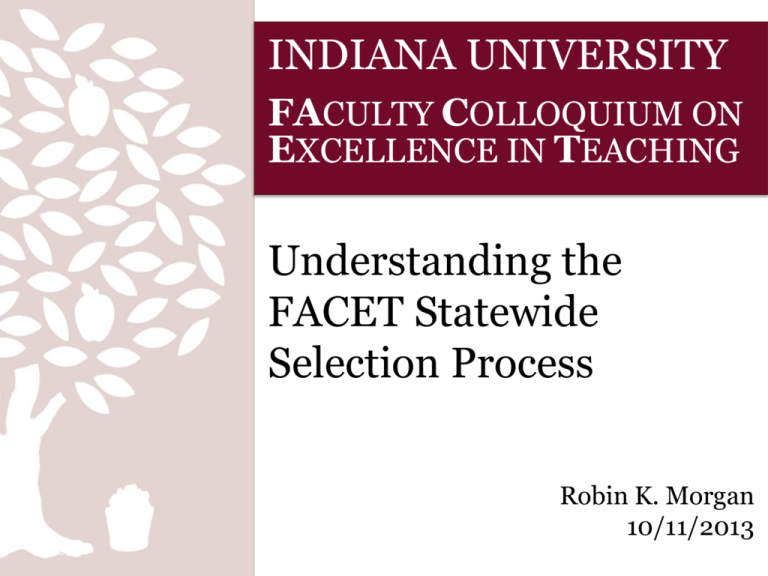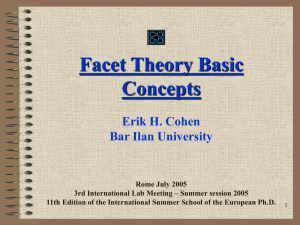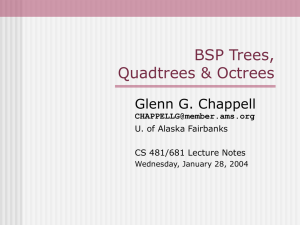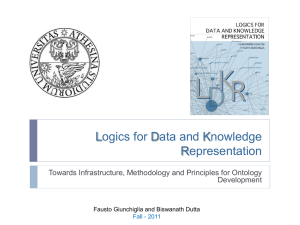HERE - Faculty Colloquium on Excellence in Teaching
advertisement

INDIANA UNIVERSITY FACULTY COLLOQUIUM ON EXCELLENCE IN TEACHING Understanding the FACET Statewide Selection Process Robin K. Morgan 10/11/2013 Statewide Procedures • All dossiers are read and rated by each statewide committee member using the rubric • One person assigned to present case • Rankings recorded • Case reviewed • Vote taken: • Full admission to FACET • Please revise and resubmit • Rejection • Letters written by Chair Evaluation Rubric Overall Rating: • Ideal match for FACET • Possible FACET match • Not appropriate for FACET but need to discuss given the current information Evaluation Rubric Teaching Philosophy: 1a. Consistent with knowledge of student learning 1b. Consistent with identified teaching goals and approaches in the feedback loop Overall Rating: Very strong____ Strong____ Weak____ Very Weak____ Evaluation Rubric Evidence from LEARN 2a. Evidence of reflection about teaching 2b. Demonstrated ability to learn from taking risks 2c. Creativity in pedagogy 2d. Development of appropriate learning goals 2e. Evidence of student learning Overall Rating: Very strong____ Strong____ Weak____ Very Weak____ Evaluation Rubric Teaching Summary 3a. Evidence of teaching scholarship 3b. Evidence of peer mentoring related to teaching 3c. Evidence of participation in professional development activities related to teaching 3d. Demonstrated leadership related to teaching Overall Rating: Very strong____ Strong____ Weak____ Very Weak____ Evaluation Rubric Evidence of potential future contributions to FACET and its mission Appendix B: Contributions to FACET: Interest Profile Overall Rating: Very strong____ Strong____ Weak____ Very Weak____ Biggest Issues? Lack of evidence of student learning SET data ≠ student learning • 95% of my students report that I am knowledgeable • Student should be able to apply concepts to novel scenarios: • Assessed on each exam • On exam 1: 25% of students succeeded • On exam 2: 57% of students succeeded • On exam 3: 86% of students succeeded Biggest Issues? Reflection/evidence-based teaching In keeping with the objective of having an interactive classroom, I encourage student creativity. Students have engaged in such diverse activities as playing games, making up new words and defining them, going on scavenger hunts, and analyzing the symbolism in an episode of M*A*S*H. Biggest Issues? Reflection/evidence-based teaching: Originally, the sophomore introduction class had very poor evaluations…The class had been formatted to …. Over the last 4 years I have changed both course content and presentation to engage students… The evaluations of students agreeing that the quality of the class is outstanding have gone from 40% to over 60% last year. Example For example, in one peer review, a suggestion was made to, “Work a participation grade into the grading structure. Perhaps add some more formal classroom assessment techniques.” I have since added participation points to the total points possible in my courses, and attendance has improved. This is important because the correlation in my courses between attendance and final grade has been as high as 0.65. Often, participation is tied to “minute papers” in which students reflect in each class on one concept that they believe they understand well and one concept that they believe requires further study. I call these “got it / didn’t get it” papers, and I have been pleasantly surprised with how seriously students take these activities. They actually state things like, “I probably need to go back and review X,” or “When I read the chapter, I didn’t really get concept Y, but your class examples helped, thanks!” These assignments not only allow me to see what I need to review more thoroughly in class, but also give students a chance for self-reflection on their studies.





